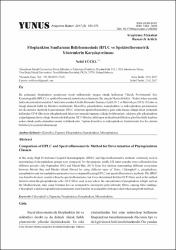| dc.contributor.author | Yücel, Nebil | |
| dc.date.accessioned | 03.07.201910:49:13 | |
| dc.date.accessioned | 2019-07-03T12:14:27Z | |
| dc.date.available | 03.07.201910:49:13 | |
| dc.date.available | 2019-07-03T12:14:27Z | |
| dc.date.issued | 2017 | |
| dc.identifier.citation | Yucel, N. (2017). Fitoplankton sınıflarının belirlenmesinde HPLC ve spektroflorometrik yöntemlerin karşılaştırılması. Yunus Araştırma Bülteni, 17(3), 163-170. doi: 10.17693/yunusae.vi.286302 | en_US |
| dc.identifier.issn | 1303-4456 | |
| dc.identifier.uri | https://hdl.handle.net/20.500.12508/393 | |
| dc.identifier.uri | http://dx.doi.org/10.17693/yunusae.vi.286302 | en_US |
| dc.identifier.uri | http://www.yunus.gov.tr/ | en_US |
| dc.description.abstract | Bu çalışmada fitoplankton gruplarının tespit edihnesinde yaygın olarak kullanılan Yüksek Performanslı Sıvı Kromatografik (HPLC) ve spektroflorometrik metotlar kıyaslanmıştır. Bu amaçla Mersin Körfezi Rodos Adası arasında farklı ekosistemleri temsilen farklı istasyondan farklı dönemde (Temmuz-Eylül 2012 ve Mart-Mayıs 2013) 152 adet su örneği alınarak farklı tip filtrelere süzülmüştür. Klorofil-a, pikoplankton, nanoplankton ve mikroplankton parametreleri her iki metotla ölçülerek kıyaslanmıştır. HPLC cihazının spektroflorometreye göre daha hassas olduğu fakat yöntemde kullanılan GF/F filtrelerin pikoplanktonik hücreleri tutmada başarısız olduğu belirlenmiştir. Akdeniz gibi pikoplankton yoğunluğunun fazla olduğu denizlerde kullanılan GF/F filtreler, nükleopor polikarbonat filtrelere göre biyokütle kaybına neden olarak yanlış okumalara neden olabilmektedir. Toplam klorofil-a ve mikroplankton ölçümlerinde her iki yöntem birbirleriyle uyumlu bulunmuştur. | en_US |
| dc.description.abstract | In this study, High Performance Liquid Chromatographic (HPLC) and Spectrofluorometric methods commonly used in determining of phytoplankton groups were compared. For this purpose, totally 152 water samples were collected in four different periods (July-September 2012 and March-May 2013) from five stations representing different ecosystems between Mersin Bay and Rhodes Island filtered by using different types of filters. Chlorophyll a, picoplankton, nanoplankton and microplankton parameters were compared by using HPLC and spectrofluorometric methods. The HPLC was found to be more sensitive than the spectrofluorometer, but it was determined that the GF/F filters used in the method failed to retain the picoplanktonic cells. GF/F filters used in seas where the concentration ofpicoplankton is high, such as the Mediterranean, may cause biomass loss as compared to nucleopore polycarbonate filters, causing false readings. Chlorophyll-a and microplankton measurements were found to be compatible with each other when using both methods. | en_US |
| dc.language.iso | tur | en_US |
| dc.publisher | Yunus Araştırma Bülteni | en_US |
| dc.rights | info:eu-repo/semantics/openAccess | en_US |
| dc.subject | Klorofil-a | en_US |
| dc.subject | Pigment | en_US |
| dc.subject | Pikoplankton | en_US |
| dc.subject | Nanoplankton | en_US |
| dc.subject | Mikroplankton | en_US |
| dc.subject | Chlorphyll-a | en_US |
| dc.subject | Pigments | en_US |
| dc.subject | Picoplankton | en_US |
| dc.subject | Nanoplankton | en_US |
| dc.subject | Mikroplankton | en_US |
| dc.title | Fitoplankton sınıflarının belirlenmesinde HPLC ve spektroflorometrik yöntemlerin karşılaştırılması | en_US |
| dc.title.alternative | Comparison of HPLC and spectrofluorometric method for determination of phytoplankton classess | en_US |
| dc.type | article | en_US |
| dc.relation.journal | Yunus Araştırma Bülteni | en_US |
| dc.contributor.department | Deniz Bilimleri ve Teknolojisi Fakültesi | en_US |
| dc.identifier.volume | 17 | en_US |
| dc.identifier.issue | 3 | en_US |
| dc.identifier.startpage | 163 | en_US |
| dc.identifier.endpage | 170 | en_US |
| dc.relation.publicationcategory | Makale - Ulusal Hakemli Dergi - Kurum Öğretim Elemanı | en_US] |
| dc.relation.publicationcategory | Makale - Ulusal Hakemli Dergi - Kurum Öğretim Elemanı | en_US |
| dc.contributor.isteauthor | Yücel, Nebil | |
| dc.relation.index | TR-Dizin | en_US |
















